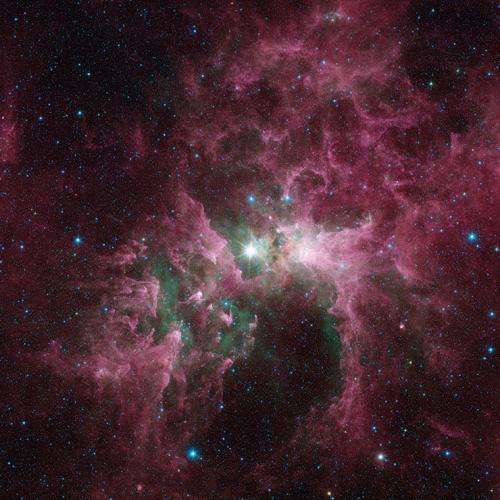Image: Spitzer at 10

The infrared observatory Spitzer has been at work for 10 years, revealing the cool dusty regions where stars and planets form, as well as shedding light on planets, exoplanets, stars and galaxies. Spitzer data have brought a better understanding of the Milky Way's spiral arm structure, led to the discovery of Saturn's largest and faintest ring, and the observatory was the first to detect light from an exoplanet. Spitzer has enabled astronomers to investigate the composition, dynamics and atmospheres of exoplanets.
This image shows the Carina Nebula, a region where dust and gas are shaped by winds and radiation from the massive star Eta Carinae (100 times the mass of the Sun). Infrared wavelength radiation from the star destroys dust, leaving cavities within the nebula surrounded by higher density "spikes".
This Spitzer image, reprocessed as part of the Galactic Legacy Infrared Mid-Plane Survey Extraordinaire (GLIMPSE) project, uses Spitzer's infrared array camera, with emission from wavelengths of 3.6 µm shown in blue, 4.5 µm in green and 8.0 µm in red. In the composite image, the dust appears red and the hotter gas, green. Spitzer was originally called the Space Infrared Telescope Facility, and was renamed after its launch in honour of the late astronomer Lyman Spitzer. It is one of NASA's Great Observatories, together with the Hubble Space Telescope, the Chandra X-ray Observatory and the now-defunct Compton Gamma Ray Observatory. Spitzer used up its coolant for longer-wavelength observations in 2009, and is now continuing to work in the "warm mission phase".
This image is published in the October 2013 issue of Astronomy & Geophysics.
Provided by Royal Astronomical Society





















